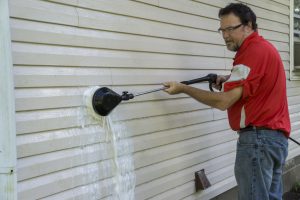Vinyl siding can be a great and cost effective addition to any home, however there are some down sides. If your home needs a bit of a face lift, and you’re thinking of going vinyl, here’s what you need to know:

Maintenance: Every siding choice will require some maintenance. While vinyl siding requires minimal short-term upkeep, a gentle washing with soap and warm water every year will likely do the trick, the caulk used to install it can wear out over time. This can lead to gaps between your siding and windows and mean additional maintenance.
Fading/ Cracks: As vinyl ages, it can fade, become weaker and crack. Since you can not paint or patch it, you will have to replace the entire panel. Luckily though, this damage doesn’t usually begin to happen until after about 10 – 15 years.
Moisture: If not properly installed, vinyl can trap moisture in between it and the wood paneling it covers. The best way to prevent this it to have your home’s wood inspected for existing dampness or mildew and have it fixed before adding new siding.
Weather damage: Vinyl expands and contracts in hot and cold weather, which over time can cause the screws and staples that hold it in place to loosen.,. That combined with harsh winds or rainfall can lead to damaged or missing siding.
Energy bills: Vinyl isn’t the best option as far as insulation goes, so it is not the best choice for those living in extreme heat or cold, however it shouldn’t pose much of a problem for people in milder climates.
Vinyl isn’t final: Then again, no siding really is. While the idea that vinyl siding will last forever is not true, it certainly lasts a long time and is fine for the typical homeowner. If you are looking for something to last decades though, wood or masonry siding might be your best option.
With the quality and durability of vinyl improving every year, it’s a great way to give your home an inexpensive touch up, but it may not be for everyone. If you’re looking to repair or replace siding, choose none other than North East Home Improvement for a variety of vinyl, cedar and fiber cement options.

Leave a Reply